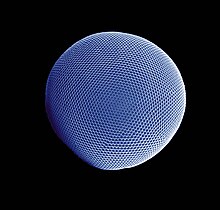Oczy złożone
Oczy złożone, oczy mozaikowe, oczy fasetkowe (l.poj. oko złożone – łac. oculus compositus) – rodzaj oczu występujący u owadów, wijów i niektórych skorupiaków. Składają się z ułożonych w charakterystyczny wzór mozaikowy omatidiów (zwanych oczkami prostymi lub fasetkami), z których każdy posiada własną rogówkę, aparat dioptryczny, komórki barwnikowe i receptory i odbiera tylko wąski wycinek pola widzenia. Daje to obraz mozaikowy, który zostaje przetworzony w układzie nerwowym. Oko złożone dostrzega intensywność światła i jego zmiany, ale nie umożliwia ostrego widzenia kształtów. Pole widzenia oczu złożonych jest bardzo szerokie i może dochodzić nawet do 360° (u drapieżnych owadów). Oczy stawonogów dają im możliwość dostrzegania szerszej gamy barw, np. pszczoły widzą ultrafiolet, a także rozróżniają polaryzację światła. Ułatwia im to orientację przy pochmurnym niebie.
Istnieją 2 typy oczu złożonych:
- oczy apozycyjne – występują u owadów dziennych. Każde z omatidiów jest otoczone komórkami barwnikowymi, które pochłaniają większość promieni świetlnych, a przepuszczają do soczewki tylko prostopadłe.
- oczy superpozycyjne – występują u owadów nocnych i wielu skorupiaków. Mają mniej omatidiów niż oczy apozycyjne, a ponadto izolacja optyczna między nimi jest wyraźnie mniejsza. Obraz przekazywany przez oczy superpozycyjne jest jaśniejszy od obrazu przekazywanego przez oczy apozycyjne, ale mniej ostry.
Zobacz też
Bibliografia
- Encyklopedia Biologia. Greg, 2008. ISBN 978-83-7327-756-4.
- Józef Razowski: Słownik entomologiczny. Warszawa: Państwowe Wydawnictwo Naukowe, 1987. ISBN 83-01-07907-X.
Linki zewnętrzne
- F.G. Varela, W. Wiitanen, The optics of the compound eye of the honeybee (Apis mellifera), J Gen Physiol. 1970 Mar;55(3):336-58
- F.G. Varela, K.R. Porter, Fine structure of the visual system of the honeybee (Apis mellifera). I. The retina, J Ultrastruct Res. 1969 Nov;29(3):236-59
- F.G. Varela, Fine structure of the visual system of the honey bee (Apis mellifera). II. The lamina, J Ultrastruct Res. 1970 Apr;31(1):178-94
- W. Wiitanen, F.G. Varela, Analysis of the organization and overlap of the visual fields in the compound eye of the honeybee (Apis mellifera), J Gen Physiol. 1971 Mar;57(3):303-25
- F.G. Varela, The vertebrate and the (insect) compound eye in evolutionary perspective, Vision Res. 1971;Suppl 3:201-9
- Carsten H.G. Müller, Andy Sombke, Jörg Rosenberg. The fine structure of the eyes of some bristly millipedes (Penicillata, Diplopoda) : Additional support for the homology of mandibulate ommatidia (Abstract). „Arthropod structure & development”. 36 (4), s. 463-476, 2007. Elsevier, Oxford, ROYAUME-UNI. ISSN 1467-8039 (ang.).
- Adrian Horridge. What does an insect see?. „J Exp Biol.”, s. 2721-2729, 2009 Sep 1. DOI: 10.1242/jeb.030916 (ang.).
Media użyte na tej stronie
Autor: Gerd Alberti and Uwe Kils, Licencja: CC-BY-SA-3.0
Compound eye of the Antarctic krill Euphausia superba
Autor: Paweł Wałasiewicz, Licencja: CC BY-SA 4.0
When zoomed, individual hexagonal units called ommatidia are visible.
Autor: Thomas Shahan, Licencja: CC BY 2.0
I don't usually repost the same animal on here twice, but I was just browsing through my archive of older bug photos taken with my Pentax *ist DL and found this nice shot of a male Tabanus lineola horse fly I took back in May 2008. I originally passed this shot up for the photo seen directly below (this one), which had a more dynamic angle and a generally more successful composition. What do you guys think?
I can remember sitting outside working on a hot summer day in 2007 and spotting one these beautiful T. lineola males land right on the sign I was painting. I was immediately awestruck by the beauty of its pale blonde compound eyes accented by the darker bands of color and just knew they would be amazing to view up close. This was early on in my experiences with macrophotography and I didn't have my camera with me at the time. I contemplated leaving my post to go find a camera, but bugs rarely stay put, and I just reminded myself of the "if they're in my area, I'll see them again" rule.
And indeed - I did spot one again in the early summer of 2008 and got some nice shots of the specimen seen here. I've spotted many stunning T. lineola males since then - but have had no luck tracking down a female of the species which have those colorful bands covering the entire eye! These guys also perform some really odd arm movements that almost remind me of the frantic signaling of salticids.
It's worth noting that male Tabanids are are completely harmless as they merely feed on nectar and pollen. It's the females that have those wonderfully vicious scissor-like mouthparts that easily rip through human flesh. To determine the gender of large Tabanids - the females are the ones with seperated compound eyes (As seen here.)
To read more about the compound eyes of arthropods check out the Wikipedia page (featuring one of my photographs as an illustration) on ommatidium here:
en.wikipedia.org/wiki/Ommatidium
...and I finally have a new piece up at my art account here:
www.flickr.com/photos/panbasket/4179859188/
I really appreciate everyone's comments and support - but once again I'm going to ask you all to refrain from posting all those big flashing group invite pictures in the comments. It's alright if you want if you want to to invite me to a group, and I appreciate the enthusiasm, but try to understand that they are interpreted by some as a bit annoying. Don't take it personally if I delete your comment due to this.
So in short - just don't follow your group rules.




